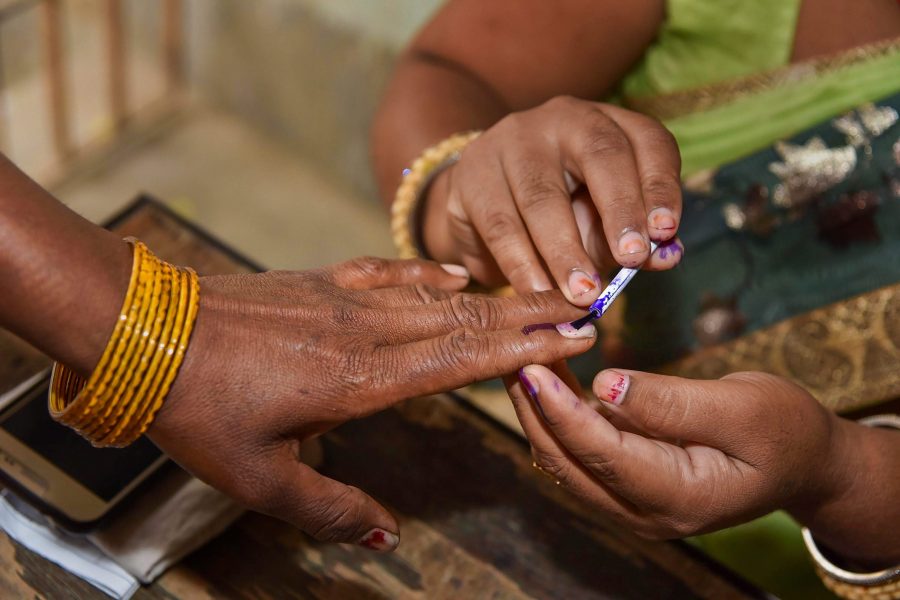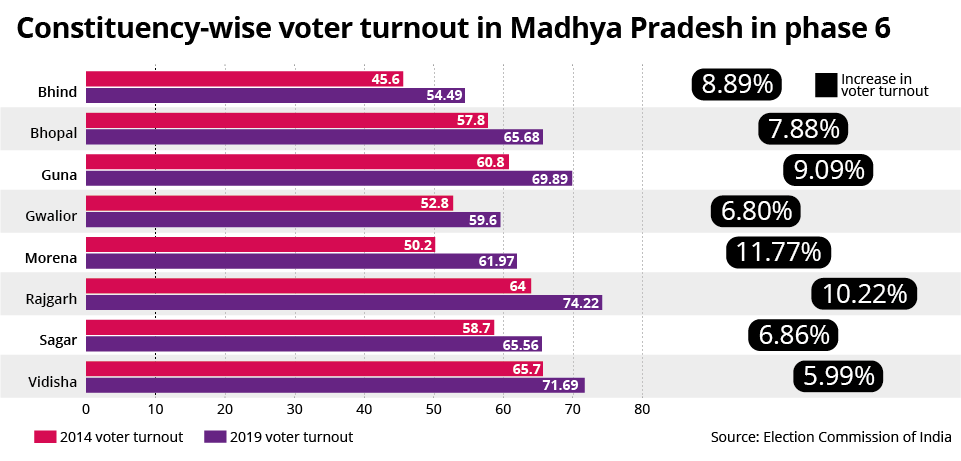
What does the high voter turnout in Madhya Pradesh in Phase 6 mean?

Madhya Pradesh recorded an average 8.43 percentage point higher voter turnout in the eight parliamentary seats that went to polls on May 12. A six per cent or higher variation in the voter turnout is taken seriously by psephologists and they consider it as an indicator of a change.
The above data compares the 2019 turnout with the 2014 parliamentary elections. But, when the 2019 turnout is compared to the 2018 Assembly elections, there are only marginal variations. In fact, there has been a slight fall in the voter turnout in some Assembly segments. In general, six to eight Assembly segments make one parliamentary seat.
The average turnout was 64.9 per cent in eight parliamentary seats, namely: Bhopal, Guna, Rajgarh, Gwalior, Morena, Bhind, Sagar and Vidisha. In 2014, the average voter turnout in the same eight seats stood at 56.95 per cent and the BJP won seven seats.

But this time the Congress expects a turnaround as the voting percentage in the parliamentary elections almost mirrors the voting percentages of the Assembly elections. Psephologists believe that parliamentary elections held within six months of Assembly elections usually reflect a similar trend.
The Congress has additional reasons to cheer as it believes that its traditional scheduled caste (SC) voters have turned up in large numbers. Partha Das, psephologist and analyst at Chanakya, told The Federal: “In Madhya Pradesh, one phenomenon that is evident is that tribals and SCs are voting very aggressively.”
Voting in large numbers
The Tikamgarh seat saw the highest jump (16 percentage points) in voter turnout in the state. One-third of the district comprises scheduled castes and scheduled tribes. In the neighbouring constituency of Chindwara, which recorded the lowest increase of 3 percentage points, half the constituents are scheduled castes and scheduled tribes. This parliamentary seat is a stronghold of Congress leader Kamal Nath — a seat he has won nine times. He vacated the seat in favour of his son after he got elected as Chief Minister.
Morena reported the highest increase (11.77 percentage points) in voter turnout, followed by Rajgarh (10.22 percentage points) and Guna (9.09 percentage points) as compared to the 2014 parliamentary polls.
Rajgharh reported the highest percentage of voter turnout at 74.22, followed by Vidisha at 70.80 per cent and state capital Bhopal at 65.69 per cent.
Morena, Rajgarh are part of the erstwhile Scindia state. Vidisha, closer to Bhopal, has always been a stronghold of the BJP, where Sushma Swaraj is the sitting MP. This time she has decided not to contest, and the Congress expects a better chance.
The voter turnout peaked in the Assembly election held in November 2018. In a majority of seats, including Bhopal Uttar, Mehgaon, Khurai, and Jaura, the voter turnout was higher in the Assembly polls, and the Congress was the winning party. It won by a margin of 22 per cent in Bhopal Uttar, which saw a 4.47 percentage point increase in voter turnout on May 12.
The voter turnout peaked in the Assembly election held in November 2018. In majority of seats including Bhopal Uttar, Mehgaon, Khurai, and Jaura, the voter turnout was higher in the Assembly polls, and the Congress was the winning party.
In seats such as Rehli and Ater, where the BJP won the 2018 Assembly elections, there has been a decline of 17.6 and 15.2 percentage points in voter turnout, respectively.
Political analysts point out that a majority of the constituencies that went for polling on May 12 are in rural areas, where the Congress seems to have a stronger hold when compared to the BJP. In the Assembly elections held in November 2018, the BJP mostly garnered votes from constituencies in urban areas, while a majority of people in rural areas voted for the Congress.
The rural segment of the state has been grappling with agrarian crisis and farmer distress. This, coupled with the BJP diluting the ST/SC (Prevention of Atrocities) Act, seems to have forced the tribals and scheduled castes to come out in large numbers to vote.
“While the Congress may get a major chunk of tribal votes, the scheduled caste votes may get divided between the BSP and the Congress,” said Das.
A better reach
The Congress is believed to have a better reach in rural constituencies. This was evident in the 2018 Assembly election where the Congress managed to wrest the state from the BJP. The party led a majority in 101 of the 193 rural and semi-rural constituencies in the state in the Assembly polls.
“In Madhya Pradesh, the Congress has a robust network. And after winning the 2018 Assembly elections, the party workers seem to have garnered momentum,” Rasheed Kidwai, a senior political journalist, told The Federal.
The party has been hoping to gain substantially in the state in the Lok Sabha polls, as it is being held within six months of the Assembly polls. In cases where elections are held in close succession, it is seen that voters tend to vote for the party that won the previous election, and the Congress’ hopes seem to be riding on this.

